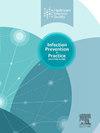Surgical prophylaxis in Haydom Lutheran Hospital, Tanzania – learning from a point prevalence survey
IF 1.9
Q3 INFECTIOUS DISEASES
引用次数: 0
Abstract
Background
Antimicrobial resistance (AMR) is a significant global health concern, with improper antibiotic use contributing to its rise. Tanzania initiated an AMR action plan in 2017, but comprehensive surveillance and stewardship efforts remain limited. This study focused on evaluating antibiotic use, particularly surgical prophylaxis, in a rural Tanzanian hospital.
Methods
The study was conducted at Haydom Lutheran Hospital in Tanzania in May 2023, using a cross-sectional point prevalence survey. Antibiotic use in all patients admitted for >24 h and those undergoing surgery was recorded, including type, dose, indication and duration. Quality indicators for surgical prophylaxis were assessed.
Results
Among 199 inpatients, 55% received antibiotics, with surgical prophylaxis accounting for 23% of prescriptions. Notably, none of the patients who received surgical prophylaxis received a single-dose regimen, and 67% exceeded the recommended 24-h duration. A combination of ampicillin-cloxacillin plus metronidazole was the most commonly prescribed combination for surgical prophylaxis (41% of prescriptions). Thirty-three percent of the antibiotics prescribed for surgical prophylaxis were classified as ‘Not recommended’ by the World Health Organization. Furthermore, 90% of surgical prophylaxis prescriptions lacked documented rationale, and 83% of prescriptions lacked stop/review dates in medical records.
Conclusion
This study reveals a high prevalence of prolonged antibiotic use for surgical prophylaxis, frequent use of antibiotics classified as ‘Not recommended’, and a lack of adequate documentation, which deviates from international standards. These practices highlight the urgent need for contextualized national guidelines, large-scale implementation projects of evidence-based interventions, and local initiatives in antibiotic stewardship, particularly in low-resource settings.
手术预防在海多姆路德医院,坦桑尼亚-从点患病率调查学习
抗生素耐药性(AMR)是一个重大的全球健康问题,抗生素使用不当导致其上升。坦桑尼亚于2017年启动了一项抗菌素耐药性行动计划,但全面的监测和管理工作仍然有限。这项研究的重点是评估坦桑尼亚一家农村医院的抗生素使用情况,特别是手术预防。方法本研究于2023年5月在坦桑尼亚的Haydom Lutheran医院进行,采用横断面点患病率调查。记录所有住院24小时及手术患者的抗生素使用情况,包括类型、剂量、适应证和持续时间。评估手术预防的质量指标。结果199例住院患者中,55%的患者使用抗生素,其中手术预防处方占处方的23%。值得注意的是,没有接受手术预防的患者接受单剂量方案,67%超过推荐的24小时持续时间。氨苄西林-氯西林联合甲硝唑是外科预防最常用的处方组合(占处方的41%)。33%用于手术预防的抗生素被世界卫生组织列为“不推荐”。此外,90%的外科预防处方缺乏书面理由,83%的处方在医疗记录中缺乏停止/审查日期。结论:本研究揭示了外科预防长期使用抗生素的高发率,频繁使用被归类为“不推荐”的抗生素,以及缺乏足够的文件,这与国际标准不符。这些实践突出表明,迫切需要根据具体情况制定国家指南,大规模实施循证干预措施项目,并在抗生素管理方面采取地方行动,特别是在资源匮乏的环境中。
本文章由计算机程序翻译,如有差异,请以英文原文为准。
求助全文
约1分钟内获得全文
求助全文
来源期刊

Infection Prevention in Practice
Medicine-Public Health, Environmental and Occupational Health
CiteScore
4.80
自引率
0.00%
发文量
58
审稿时长
61 days
 求助内容:
求助内容: 应助结果提醒方式:
应助结果提醒方式:


